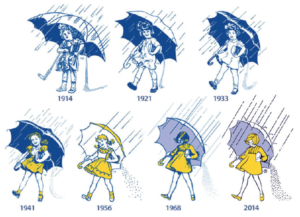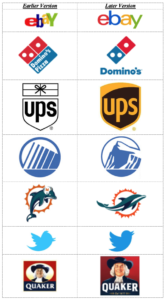Developing a recognizable consumer brand takes a significant amount of time and money. As such, trademarks, being in continuous use in commerce, barring certain exceptions, would not have a designated expiration date, unlike copyrights and patents. Therefore, maintaining brand recognition for generations may require businesses to update or even change their branding. In our modern marketing landscape, businesses must be able to adapt to change, and one way to do so is by updating their trademark(s). Trademarks are used as source identifiers for businesses and are valuable assets. Therefore, modifying the existing image while maintaining/tacking the rights associated with the current mark’s registration can be quite beneficial.
Trademark “tacking” is a legal doctrine. This doctrine allows a trademark owner to modify its trademark while retaining the first-use date of the original mark, as well as all of the original mark’s goodwill, provided that the modification creates the same, continuing commercial impression as the original mark, and would be considered by purchasers as the same mark. In other words, this doctrine permits a trademark owner to “tack” its use of a newer version of a mark onto the older version of a mark, if the newer version is a “legal equivalent” (the same, continuing commercial impression) of the older mark, thereby retaining the benefits associated with the older version.
The trademark tacking doctrine is understood best by example. One of the better examples of a successful trademark tacking is found on a kitchen staple you likely have in your cupboard, Morton® salt. Since the early 1900s, this classic container has depicted the “Morton Salt Umbrella Girl” trademark. As the image below shows, the “Morton Salt Umbrella Girl” trademark has not been stagnant over the years; rather, this trademark has been regularly modified throughout time to ensure that the Umbrella Girl’s look remains modern. As shown, each modified version of the trademark includes the same essential image showing a young girl holding an umbrella in one hand to shield against falling rain, and in the other hand, a package of salt under her arm with the spout open and salt running out.

In essence, under the trademark tacking doctrine, as long as each new version of the trademark creates the same continuing commercial impression in the minds of consumers as the prior mark, then the trademark rights acquired from the first registration should continue or be “tacked” on to the original. Without this tacking doctrine, trademark rights could be reset/reduced, each time a trademark logo is modified. This means that without this doctrine, the trademark would end up with a new first-use date and could potentially lose the rights and goodwill attached to a prior-version of the trademark.
When thinking about taking advantage of the tacking doctrine, the primary question following any change/modification is whether the change/modification causes the trademark to create a different commercial impression such that the trademark will be viewed by consumers as a new mark. If the change/modification is too great, the trademark owner could lose some or all of the trademark rights/benefits (such as the goodwill and/or date of first use) in connection with the older version of the trademark. Thus, there must be a balance between the need to update/modify a trademark while ensuring that the mark retains its same, continuing commercial impression to the ordinary consumer. In any event, modifying/updating one’s trademark is certainly a business decision and should be made on the basis of thoughtful input from an experienced trademark attorney.
The bottom line is adapting to change is not only necessary in life, but in business. Whether you realized it or not, famous marks like EBAY®, Domino’s® and UPS® (as shown below) made modifications to their company logos over the years – modifications that consumers appreciate and still recognize – modifications that helped the brand adapt and grow.
If you or your business have questions regarding your trademark, trademark rights, or are considering modifying your current trademark, please contact us at Walter Haverfield.


